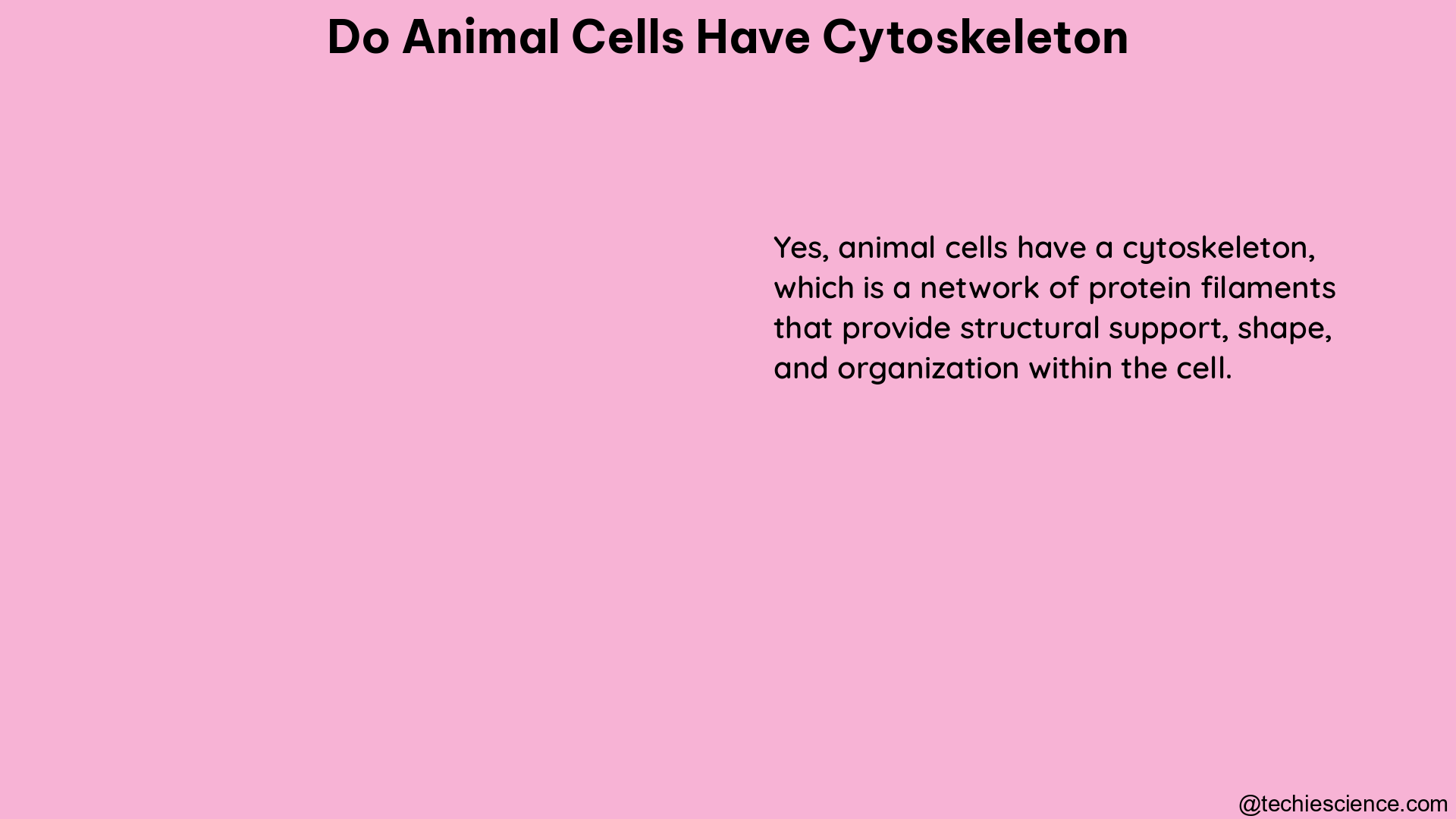Animal cells possess a complex and dynamic cytoskeleton that provides structural support, shape, and internal organization. The cytoskeleton is composed of three main types of protein filaments: microfilaments, intermediate filaments, and microtubules. Each filament type has distinct characteristics and functions that are crucial for the proper functioning of animal cells.
Microfilaments: The Actin Backbone
Microfilaments, also known as actin filaments, are the thinnest of the cytoskeletal filaments, with a diameter of approximately 6 nanometers (nm). These filaments are composed of the protein actin, which is one of the most abundant proteins in animal cells. Microfilaments play a crucial role in:
-
Cell Motility: Actin filaments, in conjunction with motor proteins like myosin, are responsible for various forms of cell movement, including amoeboid movement, muscle contraction, and the formation of lamellipodia and filopodia during cell migration.
-
Cell Division: During cell division, the actin cytoskeleton undergoes dynamic reorganization to form the contractile ring, which facilitates the physical separation of the dividing cells.
-
Maintaining Cell Shape: Microfilaments provide structural support and help maintain the overall shape and integrity of the cell, particularly in non-adherent cells.
Quantitative data on microfilaments includes the rate of actin polymerization and depolymerization, which can be measured using techniques like fluorescence microscopy and biochemical assays. The average rate of actin filament assembly has been reported to be around 2.4 μm/min, while the disassembly rate can vary depending on the cellular conditions.
Intermediate Filaments: Providing Structural Stability

Intermediate filaments have a diameter of approximately 10 nm, placing them between the thinner microfilaments and the thicker microtubules. These filaments are composed of a diverse group of proteins, including laminin, keratin, desmin, and vimentin, among others. The primary functions of intermediate filaments include:
-
Structural Support: Intermediate filaments provide mechanical support and stability to the cell, particularly under conditions of mechanical stress, such as in epithelial cells and muscle cells.
-
Organelle Positioning: Intermediate filaments help in the positioning and organization of various organelles within the cell, contributing to the overall intracellular architecture.
-
Cell-Cell and Cell-Matrix Adhesion: Certain intermediate filament proteins, like desmoplakin, are involved in the formation of desmosomes, which are specialized cell-cell adhesion structures.
Quantitative data on intermediate filaments includes the dynamics of filament assembly and disassembly, as well as the specific protein composition and distribution within different cell types. For example, the turnover rate of keratin filaments in epithelial cells has been measured to be around 1-2 hours.
Microtubules: The Intracellular Highways
Microtubules are the largest of the cytoskeletal filaments, with a diameter of approximately 25 nm. These filaments are composed of the protein tubulin, which exists in two main isoforms: α-tubulin and β-tubulin. Microtubules play a crucial role in:
-
Intracellular Transport: Microtubules serve as tracks for the movement of various organelles, vesicles, and other cellular components, facilitated by motor proteins like kinesin and dynein.
-
Cell Division: During cell division, microtubules form the mitotic spindle, which is responsible for the accurate segregation of the replicated chromosomes into the daughter cells.
-
Maintaining Cell Shape and Polarity: Microtubules contribute to the overall shape and polarity of the cell, particularly in specialized cell types like neurons and epithelial cells.
Quantitative data on microtubules includes the dynamics of microtubule assembly and disassembly, known as “dynamic instability.” This process involves the stochastic switching between phases of growth and shrinkage, which can be measured using techniques like fluorescence microscopy. The average growth rate of microtubules has been reported to be around 0.1-0.3 μm/s, while the shrinkage rate can be up to 0.3 μm/s.
Cytoskeleton Dynamics and Regulation
The cytoskeleton is a highly dynamic structure that undergoes constant remodeling and reorganization in response to various intracellular and extracellular signals. This dynamic behavior is essential for the cell to adapt to changing environmental conditions and perform various functions.
The dynamics of the cytoskeleton are regulated by a complex network of signaling pathways and regulatory proteins, such as small GTPases, kinases, and actin-binding proteins. These regulatory mechanisms control the assembly, disassembly, and organization of the cytoskeletal filaments, allowing the cell to respond to various stimuli and maintain its structural integrity and function.
Quantitative data on cytoskeleton dynamics includes the measurement of filament turnover rates, the speed and directionality of motor protein movements, and the changes in filament organization in response to different cellular conditions. These measurements provide valuable insights into the complex and coordinated regulation of the cytoskeleton.
Conclusion
In summary, animal cells possess a highly complex and dynamic cytoskeleton composed of three main types of protein filaments: microfilaments, intermediate filaments, and microtubules. Each filament type has distinct characteristics and functions that are crucial for the proper functioning of animal cells, including cell motility, cell division, intracellular transport, and the maintenance of cell shape and structural integrity.
The cytoskeleton is a highly regulated and dynamic structure that undergoes constant remodeling in response to various intracellular and extracellular signals. Quantitative data on the cytoskeleton, such as filament diameter, protein composition, and dynamics of filament assembly and disassembly, provide valuable insights into the complex mechanisms that govern the organization and function of this essential cellular component.
References:
– Pollard, T. D., & Cooper, J. A. (2009). The cell biology of actin. Cold Spring Harbor perspectives in biology, 1(1), a001625.
– Howard, J. (2001). Microtubule dynamics: the plus- and minus-end stories. Nature reviews molecular cell biology, 2(12), 927-936.
– Goldstein, L. S. B., & Yang, Z. (2000). Kinesin motors and microtubule dynamics. Annual review of biophysics and biomolecular structure, 29, 225-258.
– Chhabra, E., & Higgs, H. N. (2007). Actin dynamics in cell motility. Journal of cell science, 120(21), 3683-3694.
– Alberts, B., Johnson, A., Lewis, J., Raff, M., Roberts, K., & Walter, P. (2002). Molecular biology of the cell. Garland Science.

Hi…I am Arti Pandey, have a Master’s degree in Biotechnology. I am an academic writer in Lambdageeks and also a beginner Korean learner. I love to explore new cultures, places, and food. I love photography and had a keen interest in creative writing.